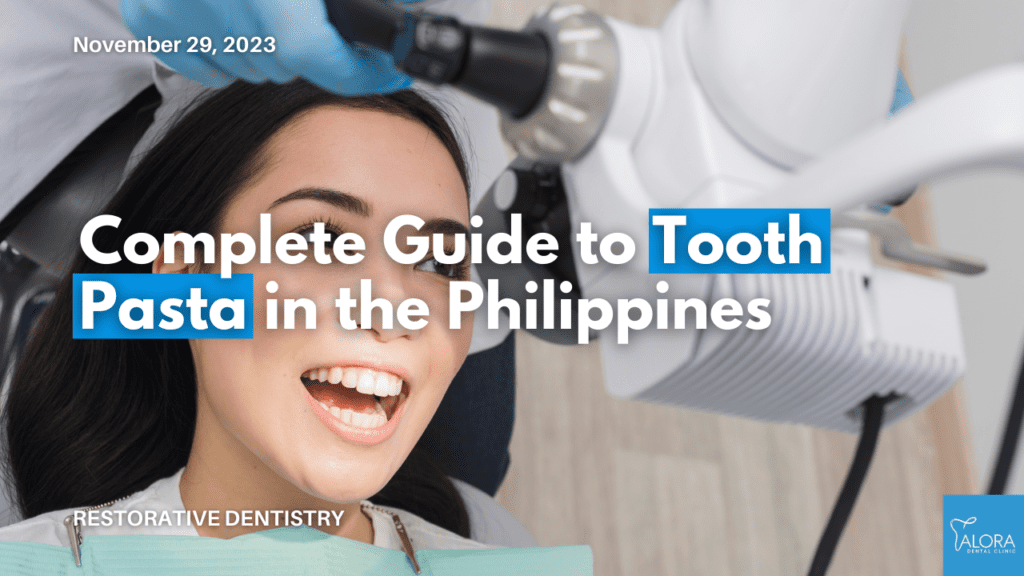Everything You Need to Know About Tooth Pasta in the Philippines

Welcome to your definitive guide on tooth pasta—a term you might find a bit quirky, but one that’s familiar in every Filipino household when it comes to dental care. In the Philippines, tooth pasta doesn’t squeeze out of a tube; it’s the local lingo for tooth fillings, an essential dental procedure that restores damaged teeth back to their glory.
This guide isn’t just a rundown of what you already know; it’s your ally in navigating the intricacies of dental health, debunking myths, and understanding the value of a smile built to last. So, let’s dive in and demystify tooth pasta—your teeth’s best friend!
Understanding Tooth Pasta
Tooth pasta may sound like something from a culinary experiment, but in dental terms, it’s what many Filipinos call a dental filling. It’s not just about plugging holes; it’s a craft of precision that gives your teeth a new lease on life. But what exactly goes into this ‘pasta’?
Materials Made to Match:
In the Philippines, dental fillings come in materials as diverse as the archipelago itself. From the strength of composite resins that blend seamlessly with your natural tooth color to the durability of ceramic fillings that stand the test of time and coffee stains, each material is a choice that matters.
The Procedure, Simplified:
Imagine your tooth is like a mini fortress, and decay has breached its walls. Tooth pasta is the reinforcement that re-fortifies your tooth’s defenses. The procedure starts with evicting the decay—like a gentle conquest over the invaders, followed by a meticulous cleanup. Then, akin to a sculptor with their clay, your dentist molds the filling material into place, restoring the tooth’s shape and function.
Why It Matters:
Beyond the obvious aesthetic reasons, tooth pasta is a guardian of oral health. It’s not just filling; it’s preventing further decay, stopping pain in its tracks, and letting you enjoy that crunchy lechon or sweet halo-halo without a wince.
In this section, we’ve sidestepped the clinical jargon to bring you a clear view of what tooth pasta is all about. Up next, we’ll talk brass tacks—the costs and considerations that come with it.
Tooth Pasta Procedure Explained

When it comes to tooth pasta, it’s not just about filling a gap—it’s about restoring the integrity of your tooth. Here’s how the typical tooth pasta journey unfolds:
- Diagnosis: It all starts with a discovery. Your dentist is like a detective, using tools and expertise to identify the culprit: tooth decay.
- Removal of Decay: Think of this as the cleanup crew getting rid of the unwanted elements, ensuring nothing harmful remains.
- Preparing the Space: This is where precision comes in. Your dentist prepares the cavity, creating a clean canvas for the filling.
- Choosing Your ‘Pasta’: You’ll select your filling material—each with its own merits. Whether it’s the affordability of composite or the longevity of ceramics, it’s a choice tailored to your needs.
- Filling the Tooth: The tooth pasta is then meticulously applied, shaped, and polished, giving your tooth back its structure and function.
- The Finale: A final check to ensure everything is set perfectly, and you’re ready to go with a renewed smile.
Throughout the process, comfort is key. With advances in dental technology, discomfort is minimized, and the results are maximized.
Costs and Considerations (how much is it?)
Understanding the costs involved with tooth pasta is crucial. It’s an investment in your oral health, and we believe you should go into it with as much knowledge as possible:
- Price Range: The cost of tooth pasta can vary. In the Philippines, you might expect to pay anywhere from Php 800 for a simple composite resin filling to around Php 5,000 for a high-end ceramic option.
- Factors Affecting Cost: Several factors can influence the price you pay, such as the size of the cavity, the type of material used, and the dentist’s expertise. Location can also play a part; prices may vary from one region to another.
- Insurance and Payment Options: We’ll delve into the nitty-gritty of insurance coverage in the Philippines—what’s typically covered, what’s not, and how to make dental care more affordable.
- Quality vs. Cost: It’s tempting to go for the cheapest option, but we’ll discuss why quality shouldn’t be compromised and how it can save you money in the long run.
This section doesn’t just throw numbers at you; it gives you a framework to understand where your money goes and why investing in a good tooth pasta can save you from future dental woes.
Aftercare and Maintenance (what's next?)

Now that your tooth has been restored with tooth pasta, what’s next? Just like any other restoration work, the longevity of your dental fillings relies heavily on aftercare.
- Immediate Aftercare: Post-procedure, it’s normal to experience sensitivity. Avoid hot, cold, or very crunchy foods for the next few days to give your new filling a chance to settle.
- Daily Maintenance: Treat your filled tooth just like its neighbors. Regular brushing, flossing, and using an antiseptic mouthwash can keep the tooth strong and healthy.
- Regular Check-Ups: Regular visits to the dentist aren’t just for cleaning; they’re also for catching any potential issues with your fillings early on.
- When to Seek Help: If you notice any sharp edges, cracking sounds, or persistent discomfort, it’s time to revisit your dentist.
Choosing the Right Dentist
The dentist who handles your tooth pasta can make a world of difference. Here’s how to find the right one:
- Credentials and Experience: Look for a dentist with a proven track record. The right qualifications and experience matter.
- Up-to-Date Techniques: Dentistry is always advancing. Choose a dentist who stays current with the latest in dental care.
- Patient Comfort: Your comfort should be a priority. A good dentist ensures a smooth and comfortable experience.
- Reviews and Testimonials: Learn from others’ experiences. Online reviews and testimonials can provide valuable insights.
- Consultation: A good dentist will offer you a consultation to discuss your needs and concerns before the procedure.
Choosing the right dentist means choosing someone who’s not just good with ‘tooth pasta’ but is also a good listener and a partner in your dental health journey.
Alternatives to Tooth Pasta (what are your options?)
Tooth pasta is not a one-size-fits-all solution. Depending on the extent of tooth damage, other options may be more suitable.
- Dental Crowns: For teeth that are significantly damaged, a crown may be recommended to cover and protect the remaining tooth structure.
- Inlays and Onlays: When the damage is too extensive for fillings but not enough for a crown, inlays and onlays can be the middle ground.
- Dental Implants: In cases where a tooth can’t be saved, dental implants offer a permanent solution.
We’ll explore when each of these alternatives is appropriate and how they compare to ‘tooth pasta’ in terms of durability, appearance, and cost.
Frequently Asked Questions:
Tooth pasta can be used for most types of cavities, whether they are small, medium, or large. However, if the decay is extensive and affects a large portion of the tooth or its structure, alternative treatments like crowns or inlays/onlays might be recommended by your dentist.
Signs that your tooth pasta may need replacement include sensitivity or pain in the treated tooth, visible wear or damage to the filling, and changes in color or texture. It’s best to have regular dental check-ups to monitor the condition of your fillings.
After getting tooth pasta, it’s advisable to avoid chewing on hard or sticky foods for a couple of days to allow the filling to set properly. Also, maintain good oral hygiene and follow any specific advice given by your dentist.
Yes, it’s normal to experience some sensitivity after the procedure, especially to hot and cold temperatures. This should subside within a few days to a week. If sensitivity persists or worsens, contact your dentist.
The lifespan of tooth pasta varies depending on the material used and your oral habits. On average, a dental filling can last anywhere from 5 to 15 years. To prolong the life of your fillings, maintain rigorous oral hygiene, visit your dentist regularly, and avoid habits like teeth grinding and chewing hard objects.
Conclusion

As we conclude our comprehensive exploration of tooth pasta, we’ve traversed from the essential basics to the intricate details of costs, procedures, and aftercare. Our intention was always twofold: to enlighten you with valuable information and to equip you for an informed dialogue with your dental specialist.
Remember, your smile is a reflection of your well-being and joy. With the right care, choice materials, and a compassionate dental partner like Alora Dental Clinic, it’s not just an asset for today—it’s an investment in your lifelong happiness. If you have any questions or wish to discuss your dental health, we warmly invite you to get in touch with us.
Meet Your Dentist...
Step into Alora Dental Clinic and let us introduce you to our passionate and dedicated dentist, Dr. Angelica Eden Astillero. She’s the type of person who lights up a room with her warm and approachable demeanor. And that’s just the start of what makes her an exceptional dentist.
Dr. Astillero graduated from the University of the East, where she developed a love for dentistry and helping others. Her commitment to continuing education and the latest dental techniques allows her to provide top-notch care to patients of all ages. But what truly sets her apart is her ability to connect with her patients and put them at ease.

Get in touch!
Where to find us?
53 Narra St, Project 3, Quezon City, 1102 Metro Manila
Call us at:
0955-827-6875


